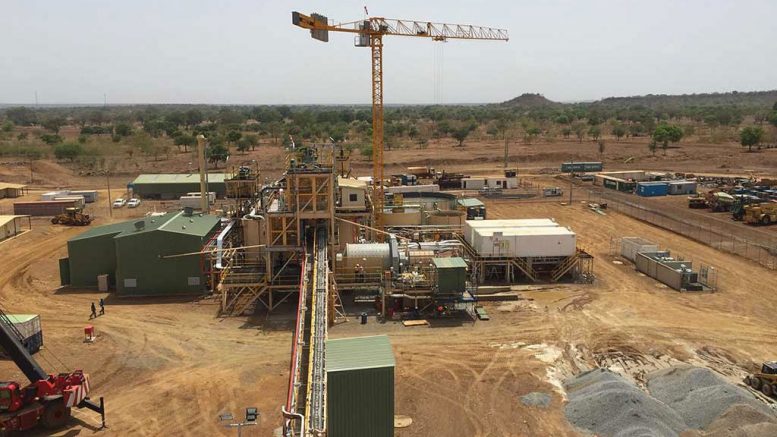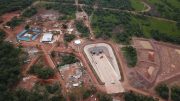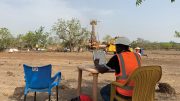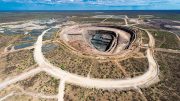Roxgold’s (TSX: ROXG; US-OTC: ROGFF) Yaramoko gold mine in southwestern Burkina Faso churned out 33,652 oz. gold in the first quarter, delivering a 16% return on equity for the company — one of the highest in the industry.
Earnings before interest, tax, depreciation and amortization margins totalled 38%, with cash-operating costs of US$468 per oz. produced, and all-in sustaining costs (AISCs) of US$775 per oz. sold.
“It’s a combination of very strong margins we’re generating at Yaramoko, and what was a very capital-efficient project,” John Dorward, the company’s president and CEO, says of Roxgold’s strong financial results. “We didn’t have to invest a lot of capital initially — and even on an ongoing basis — to generate those types of returns, because it’s a high-grade, low-cost, high-margin project.
“We’ve always wanted to be a company that mines for margins, not just ounces, and generates strong returns on investor capital, and offers our shareholders growing resources, reserves, earnings and cash flow per share.”
The company also seeks a declining share balance, Dorward says, noting that in the first three months of the year, Roxgold repurchased and cancelled 4.95 million common shares at an average price of 84¢ per share, and in early June announced plans to buy up to 10 million more shares over the next year.
Roxgold’s Yaramoko mine in the Houndé greenstone belt region in Balé province, 200 km southwest of the capital city of Ouagadougou, consists of two gold deposits: the 55 Zone, a fully underground mine, and Bagassi South, which could achieve commercial production in the second quarter.
The company expects pre-commercial production development spending at Bagassi South will come in at US$12 million to US$15 million.

The processing plant at the Yaramoko gold mine in Burkina Faso, which Roxgold expanded to a 1,100-tonne-per-day capacity in 2018. Credit: Roxgold.
“It has gone well for us since we started operations there in December,” Dorward says. “We’ve ramped up operations, and now we’re stoping. Development is going well, so we feel very good about Bagassi South, and we like what we see underground there. The grades are picking up, and we’ll see that flow through our production and costs in the second half.”
This year, Roxgold expects Yaramoko will produce between 145,000 and 155,000 oz. gold, at cash-operating costs between US$440 and US$470 per oz., and AISCs between US$765 and US$795 per ounce.
The 55 Zone mine went from discovery in 2011 to production in five years — early and under budget. Production began in May 2016, and commercial production was announced in October 2016.
The 55 Zone mine operates at 1,100 tonnes per day, and uses longhole stoping with cemented rock fill as its main mining method. The mine has proven and probable reserves to 750 metres’ depth of 1.8 million tonnes grading 11.47 grams gold per tonne for 662,000 contained oz. gold. Roxgold has increased inferred resources at depth in the 55 Zone, and plans to infill drill for conversion to reserves.
Roxgold is also trying to lower costs by supplementing Yaramoko’s grid power supply with low-cost solar generation. “We looked at solar as a component of our power mix when we did the feasibility study, but we really didn’t have the minimum 10-year mine life required to make it economical,” Dorward says. “But in the intervening years, the technology has improved, and so the economics have improved, and we have received a number of proposals from third-party solar power providers to basically build a solar power station at their cost, and then we’d buy the solar power at a significantly lower cost, so it’s something we will probably pursue, and it is a good sign of where the industry is headed.”
Dorward says that solar power would be 35% cheaper per kilowatt hour than the price Roxgold pays for power from the national grid.

The portal at Roxgold’s Bagassi South gold mine in Burkina Faso. Credit: Roxgold.
“We’d just be looking at a daytime solar system — not battery technology, or other storage, at this stage — so we’d run solar during the day, and then draw grid power for the evening.”
Elsewhere in West Africa, Roxgold has kicked off a 28,000-metre drill program in Côte d’Ivoire. Earlier this year, Roxgold acquired the Séguéla project and its near-surface Antenna deposit, as well as a portfolio of exploration permits, from Newcrest Mining (ASX: NCM) for US$20 million. The transaction closed in April.
“The first target for drilling was the Antenna open pit, so we’re in the process of finalizing a resource estimate for Antenna, which will update the historic drill resource that Newcrest did, and will incorporate additional holes that Newcrest drilled, but didn’t include in their resource,” Dorward says. “We like what we see, and the impact from that is going to be positive.”
Roxgold expects to complete a initial, National Instrument 43-101 compliant resource on Antenna by July.
The company also plans to drill targets on the 3,298 sq. km land package based on early-stage drilling Newcrest completed at the Boulder, Agouti, Ancien, Gabbro, P3 and Kwenko prospects.

Roxgold president and CEO John Dorward (left) and Paul Criddle celebrating the first gold pour at Roxgold’s Yaramoko gold mine in Burkina Faso. Credit: Roxgold.
Drill results not previously released at Boulder — 2 km east–northeast of the Antenna deposit, for instance — returned 7 metres of 9 grams gold per tonne from 18 metres downhole in 161, and 6 metres of 25.2 grams gold from 145 metres in 162. At Agouti, 1.5 km along strike from Boulder, previous holes returned 5 metres of 20.4 grams gold from 44 metres downhole in 152, and 5.1 grams gold over 11 metres from 21 metres downhole in 187.
Five kilometres south of Antenna, at the Ancien prospect, drill hole 172 cut 9.3 grams gold over 16 metres from 37 metres downhole. At Gabbro, 5 km northeast of Antenna, drill hole 3907 cut 12 metres from surface of 1.14 grams gold, while at the P3 target, 14 km northeast of Antenna, drill hole 5402 returned 3 metres of 15 grams gold from surface, and 5403 returned 14 metres of 4.5 grams gold from 3 metres downhole.
“We’re looking for more things like Séguéla. Good-quality projects — which might not meet the size requirement of a major — would be of interest to us,” Dorward says.
Roxgold has traded in a 52-week range of 72¢ to $1.22 per share, and at press time traded at $1.06. The company has a $392-million market capitalization.
“We had a big overhang in our shares from last year, when our second-largest shareholder lost the mandate for its precious metal fund, and that hung over our stock for a long time,” Dorward says. “Everyone assumed they would sell, and ultimately they did, but they hung on for about eight months, and that big block of shares cleared in February, and they’ve gone to very good homes — good, long-term investors — and we’ve had a lot more volume in our trading of late. So that was unsettling for our stock over the course of the second half of last year, but that’s behind us now, and that’s positive.”
Roxgold is also heading towards qualifying for the GDXJ, which requires an average trading value of US$1 million a day for a three-month period over three consecutive index quarters, amongst other requirements. Roxgold has met the last two consecutive quarters, and entered their third quarter in June.
The company ended the quarter with US$47.8 million in cash and long-term debt of US$34.8 million.






Be the first to comment on "Roxgold has strong quarter at Yaramoko in Burkina Faso"